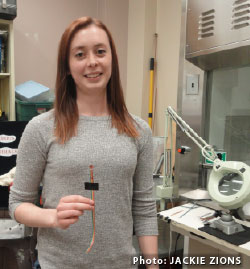Effects of Shoeing on the Loading Pressure on Joints of Quarter Horses
by: Nicole Weidner
As a horse owner, one of the many questions you will almost inevitably ask yourself is “to shoe or not to shoe?” Many variables may affect your answer, and an exciting new research project at the University of Guelph should soon shed some more light on this age-old question. Dr. Jeff Thomason is working on a project investigating the changes of loading pressure on the joints of quarter horses as it relates to shoeing for the summer. Most of the current research in this area has focused on thoroughbreds and standardbreds, which is one of the reasons scientists chose to use quarter horses for the current study. This study will help researchers better understand how the loading pressure placed on our horses’ joints may change when we shoe our horses.
Danielle Halucha, a student in Thomason’s lab, is working on the project for the summer and gave a brief explanation of the study design, “First, horses with shoes on are evaluated while performing several different exercises at different gaits with a rider on. Then, the shoes are removed and the horses are allowed time to adjust. The same horses are then re-evaluated performing the same exercises and gaits, with the same rider on, but without shoes.” The horses are evaluated moving in a straight line and around corners, and researchers use four different sensors, as well as reflective equipment, to monitor the horses speed and movements. The effects of shoe versus no shoe are investigated with several variables, including differences in footing/surfaces (e.g. concrete, rubber mat, dirt), direction (using a figure eight pattern), gait, and lead and counter-lead (at a canter).
It’s obvious that Halucha has enjoyed the time she has spent on this project so far, and is excited at what the findings will reveal. She enthusiastically shared that she will be starting a Master of Science degree with Dr. Thomason in the fall, investigating asymmetrical limb loading in thoroughbreds. Stay tuned to Equine Guelph communications for results of this and more exciting new research projects.
If you’re interested in learning more about your horse’s joints, visit Equine Guelph’s interactive Journey through the Joints learning tool. This user-friendly tool uses fun activities allowing you to discover what is normal and what is not when it comes to joints. You will learn the anatomy of your horse’s joints, and take a 360-degree tour of an actual horse joint.











